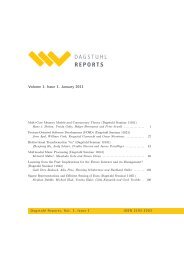Linking Sheet Music and Audio – Challenges and New Approaches
Linking Sheet Music and Audio – Challenges and New Approaches
Linking Sheet Music and Audio – Challenges and New Approaches
Create successful ePaper yourself
Turn your PDF publications into a flip-book with our unique Google optimized e-Paper software.
12 <strong>Linking</strong> <strong>Sheet</strong> <strong>Music</strong> <strong>and</strong> <strong>Audio</strong> Recordings<br />
4.1 <strong>Sheet</strong> <strong>Music</strong>-<strong>Audio</strong> Mapping<br />
Arranging the music data in a digital library in a work-centered way or, more precisely, piece<br />
of music-wise has proven beneficial. Thus in the context of a digitization project to build up<br />
a large digital music library, one important task is to group all documents that belong to<br />
the same piece of music, see Figure 1. Note that in this scenario, the music documents that<br />
are to be organized are not given as individual songs or movements, but rather as complete<br />
sheet music books or audio CD collections that usually contain several pieces of music. 17 In<br />
addition, we typically have to deal with numerous versions of audio recordings of one <strong>and</strong> the<br />
same piece of music, 18 <strong>and</strong> also with a number of different score versions (different publishers,<br />
piano reductions, orchestra parts, transcriptions, etc.) of that piece. Thus, the final goal at<br />
this level of detail is to segment both the score books <strong>and</strong> the audio recordings in such a way<br />
that each segment corresponds to one piece of music. Furthermore, each segment should be<br />
provided with the appropriate metadata. This segmentation <strong>and</strong> annotation process, called<br />
sheet music-audio mapping, is a crucial prerequisite for the sheet music-audio synchronization<br />
described in the previous section. One possibility to solve this task is to manually perform<br />
this segmentation <strong>and</strong> annotation. However, for large collections this would be an endless<br />
undertaking. Thus semi-automatic or even fully automatic mapping techniques should be<br />
developed.<br />
For audio recordings <strong>and</strong> short audio extracts, music identification services like Shazam 19<br />
can provide a user with metadata. Furthermore, ID3 tags, CD covers, or annotation databases<br />
such as Gracenote 20 <strong>and</strong> DE-PARCON 21 can contain information on the recorded piece of<br />
music. However, their automated interpretation can quickly become a challenging task. To<br />
name just two prominent issues, the opus numbers given by the different sources might not<br />
use the same catalogue or the titles might be given in different spellings or different languages.<br />
Furthermore, the mentioned services do not provide information for public domain recordings.<br />
Another issue can be introduced by audio tracks containing several pieces of music. Here,<br />
the exact start <strong>and</strong> end positions of the individual pieces of music have to be determined. 22<br />
However, this information is usually not provided on CD covers or in metadata databases.<br />
Still, the mentioned information sources can be used to support the manual segmentation<br />
<strong>and</strong> annotation process. The automatic extraction <strong>and</strong> analysis of textual information on<br />
scanned score images has to be considered at least equally challenging.<br />
Given one annotated audio recording of all the pieces contained in a score book, Fremerey<br />
et al. [25, 27] propose an automatic identification <strong>and</strong> annotation approach for sheet music<br />
that is based on content-based matching. One key strategy of the proposed procedure is to<br />
reduce the two different types of music data, the audio recordings as well as the scanned<br />
sheet music, to sequences of chroma features, which then allow for a direct comparison across<br />
the two domains using a variant of efficient index-based audio matching, see [33]. To this<br />
end, the scan feature sequence is compared to the audio feature sequence using subsequence<br />
dynamic time warping. The resulting matching curve combined with the information on the<br />
17<br />
In the context of the Probado project, the Bavarian State Library in Munich digitized more than 900<br />
sheet music books (approx. 72, 000 score pages) <strong>and</strong> about 800 audio CDs.<br />
18<br />
For example, the British Library Sounds include recordings of about 750 performances of Beethoven<br />
String Quartets, as played by 90 ensembles, see http://sounds.bl.uk/Classical-music/Beethoven<br />
19<br />
http://www.shazam.com<br />
20<br />
www.gracenote.com<br />
21<br />
http://www.de-parcon.de/mid/index.html<br />
22<br />
Usually, longer periods of silence can hint at the beginning of a new piece. However, the direction attacca<br />
resulting in two successive movements played without a pause, can prevent this clue from existing.













